I can’t remember how old I was when playing Tic-Tac-Toe became too predictable to be interesting. But I’ve now learned versions that add new twists to the game. Here are five suggestions for reviving the game of Tic-Tac-Toe and engaging kids in thinking about new twists and new strategies. Check the end of the post for ideas about introducing these games to kids and some additional information.
Twist #1: Your Choice Tic-Tac-Toe
What’s the same as playing the regular game is that you take turns as you usually do. What’s different is that you don’t start by deciding who is X and who is O. Instead, on your turn, you may write either an X or an O in any empty square, and you can change your mind from turn to turn. So can your opponent. The winner is the same as in the regular game―whoever completes a row with three Xs or three Os wins―whether or not that player actually wrote them all.
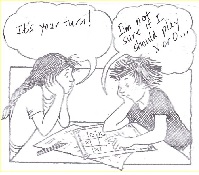
Twist #2: Number Tic-Tac-Toe
You don’t use Xs or Os for this version. Instead you use the numbers from 1 to 9, and each of these numbers can be played only once in a game. You take turns as usual. On your turn, write a number (that hasn’t yet been used) in an empty square. The winner is the player who gets the numbers in any row, column, or diagonal to add up to 15.
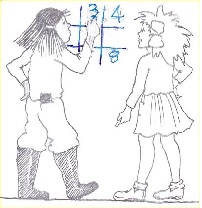
Twist #3: Last One Wins Tic-Tac-Toe
You’re back to Xs and Os for this game, but in a different way. Here’s how to play: Suppose you’re playing X. On your turn, you can mark Xs in as many squares as you’d like, as long as the squares you mark are all in the same row or column. (You can’t play on a diagonal for this game.) Whoever fills in the last space is the winner.
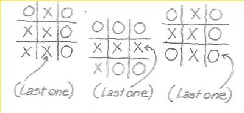
Twist #4: Tic-Tac-Toe for a Crowd
This game works for three to six people. When you draw a tic-tac-toe board for a standard game, you draw two lines vertically and two lines horizontally to create a board with nine squares. For this game, you need a giant tic-tac-toe board that you draw with 10 or so lines both vertically and horizontally. The exact number of lines you draw isn’t important, just so the game board is BIG. Then each player chooses a different letter or symbol. The idea is the same as tic-tac-toe, except that instead of winning with three in a row, the winner has to get four in a row, horizontally, vertically, or on a diagonal.
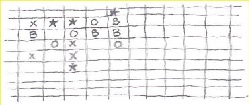
Twist #5: Ultimate Tic-Tac-Toe
I learned this game from Ben Orlin’s book, Math with Bad Drawings. You can read about the game of Ultimate Tic-Tac-Toe here. Or read the rules below and try playing. If the rules below are confusing, you can watch this YouTube video that made the rules clear to me.
Rules for Playing Ultimate Tic-Tac-Toe
Draw a tic-tac-toe board like this one, with a small tic-tac-toe board in each square of a big tic-tac-toe board, so there are 81 squares in all.
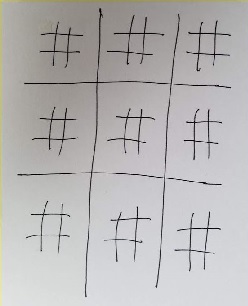
The first player plays an X in any of the 81 small squares on the board.
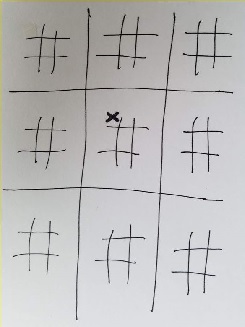
Then O plays, but has to play in a particular square of the big board that’s determined by where the X was played. This is the tricky part to understand and the key to playing. Because X played in the middle big square with an X in the upper left square in the little board, that upper left position dictates that O must play in the upper left square of the big board, in any open square in that little board. In the board below, O played in the upper left square of the big board with an O in the lower left corner of that little board..
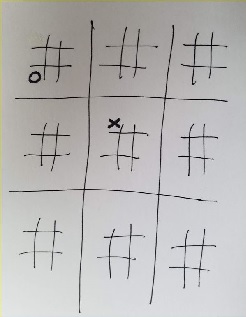
And this is how play continues. If you’re confused, this might be a good time to watch the YouTube video.
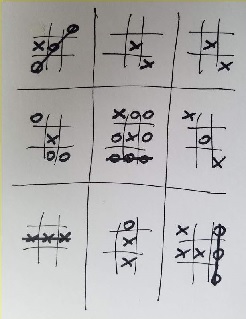
How does someone win? If you make a row of Xs or Os in any little board, you capture that entire square of the big board. Then, if you capture a row on the big board by capturing each of the little boards in that row, you win. Here’s how a completed game might look.
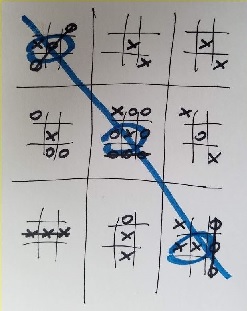
Confused? I was, until I tried the game. Once I got the hang of moves, the game became interesting, Really, really interesting. And, for a while, addictive.
Ideas for Using the Games with Kids
1. Number 1 Rule: Encourage playing the games, but don’t force it!
2. Introduce new versions of Tic-Tac-Toe with a light touch. Maybe play a sample game.
3. Encourage kids to think about strategies. Maybe ask them to describe their strategies in writing.
4. Ask kids to invent their own twists on Tic-Tac-Toe.
5. Suggest to kids that they research information about the game of Tic-Tac-Toe. (Below is some of what I learned from rummaging online.)
Tic-Tac-Toe Info
Here’s some of what I learned from my online search:
- Children as young as 3 years of age can play, though several online entries mentioned that young children might not play precisely according to the rules or even know what it means to play a competitive game. Some young children are fine with playing until both players get three in a row so both are winners. Actually, I like this idea.
- There are lots of opportunities to play tic-tac-toe online, but it seems to me that this is computer overkill since it’s so quick and easy to create a gameboard. And creating a gameboard gives kids the chance to practice drawing straight lines (more or less).
- I found a serious article titled “Stage in Children’s Play of Tic Tac Toe” from the Journal of Research in Childhood Education (Volume 4, 1990, Issue 2). The article is based on a study of how 102 children, ages 3 to 9, play and think about the game. The article is available for purchase, but while I do have time these days while sheltering at home, I chose not to dig in further. But, if you’re interested.
- Many sites make claims for the benefits of children playing Tic-Tac-Toe, that playing it contributes to children’s developmental growth. I saw a variety of benefits mentioned on different sites―problem solving, spatial reasoning, hand-eye coordination, taking turns, thinking strategically, good sportsmanship, understanding predictability.
- The game of Tic-Tac-Toe is also known as Noughts and Crosses, Xs and Os, and by other names. It’s been around for several centuries, but its history is mysterious. One site claimed it was originally invented in ancient Egypt over 3000 years ago.
- About the name Tic-Tac-Toe, I read that it comes from a game by the same name, no longer played, in which players with their eyes closed tossed a pencil down onto a slate marked with numbers, and earned the score the number indicated―something like playing darts blindfolded. That game dates to the mid- to late 1800s.
These games are all from Math for Smarty Pants, a book I wrote a while ago. If you’re interested in the year I wrote it, which was the year before it was first published, just add the numbers in any row, column, or diagonal in the square below. Or, if you prefer, add the numbers in the four corners plus the middle number. Or just look on the copyright page.

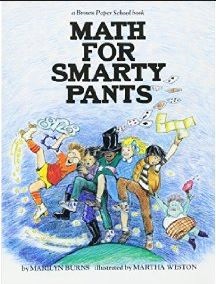
Have fun! And please post any versions you’ve invented or learned about.


awesome games and twists memorable